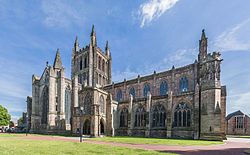| Hereford Cathedral | |
|---|---|
| Cathedral of Saint Mary the Virgin and Saint Ethelbert the King | |
 Cathedral from the north-west | |
| 52°03′15″N 2°42′58″W / 52.0542°N 2.7160°W | |
| Location | Hereford, Herefordshire |
| Country | England |
| Denomination | Church of England |
| Tradition | Broad church |
| Website | hereford cathedral.org |
| Architecture | |
| Previous cathedrals | 1 |
| Style | Gothic (Early English) |
| Years built | 1079-c.1250 |
| Specifications | |
| Length | 342 ft (104.2m) |
| Nave length | 158 ft (48.2m) |
| Choir length | 75 ft (22.9m) |
| Nave width | 73 ft (22.3m) |
| Width across transepts | 256 ft (78m) |
| Height | 165 ft (50.3m) |
| Nave height | 64 ft (19.5m) |
| Choir height | 62 ft (19m) |
| Number of towers | 1 |
| Tower height | 165 ft (50.3m) |
| Administration | |
| Province | Canterbury |
| Diocese | Hereford (since 680) |
| Clergy | |
| Dean | Sarah Brown |
| Precentor | Andrew Piper |
| Chancellor | James Pacey |
| Laity | |
| Director of music | Geraint Bowen |
Hereford Cathedral, formally the Cathedral of Saint Mary the Virgin and Saint Ethelbert the King in Hereford,[1] is a Church of England cathedral in Hereford, England. It is the seat of the bishop of Hereford and the principal church of the diocese of Hereford. The cathedral is a grade I listed building.[2]
A place of worship has existed on the site of the present building since the 8th century or earlier. The present building was begun in 1079.[3] Substantial parts of the building date from both the Norman and the Gothic periods.
The cathedral has the largest library of chained books in the world, its most famous treasure being the Mappa Mundi, a medieval map of the world created around 1300.[3] The map is listed on the UNESCO Memory of the World Register.[3]
- ^ Annual Report of the Chapter and Accounts Year Ended 31 December 2023. Hereford Cathedral.
- ^ Historic England. "Cathedral Church (1196808)". National Heritage List for England. Retrieved 21 November 2008.
- ^ a b c "Our history". Hereford Cathedral. Archived from the original on 11 May 2019. Retrieved 5 October 2018.
